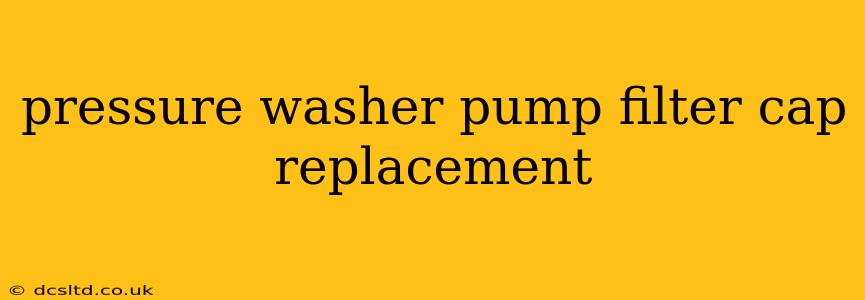Maintaining your pressure washer is crucial for its longevity and optimal performance. One often-overlooked component is the pump filter cap. This seemingly small part plays a vital role in protecting your pressure washer's pump from debris and damage. Regular inspection and timely replacement of the filter cap can prevent costly repairs and extend the lifespan of your machine. This guide will walk you through everything you need to know about pressure washer pump filter cap replacement.
Why is Replacing the Pressure Washer Pump Filter Cap Important?
The pump filter cap houses a fine mesh filter that prevents dirt, grit, and other debris from entering the pump. These contaminants can cause significant damage, including:
- Internal pump damage: Debris can scratch or damage internal pump components, leading to reduced pressure, leaks, or complete pump failure.
- Reduced pressure: A clogged filter restricts water flow, resulting in significantly lower cleaning power.
- Premature wear and tear: Continuously forcing water through a clogged filter puts extra strain on the pump, accelerating wear and tear.
Regularly checking and replacing the filter cap ensures your pressure washer operates at peak efficiency and prevents these problems.
How Often Should I Replace the Pressure Washer Pump Filter Cap?
There's no single answer to this question, as the frequency depends on several factors:
- Water source: Using water from a muddy source or a water supply with a high sediment level will require more frequent replacements.
- Usage frequency: The more frequently you use your pressure washer, the faster the filter will clog.
- Type of cleaning: Cleaning tasks involving heavy debris will necessitate more frequent filter checks.
As a general rule, inspect the filter cap and filter at least once a month, or more often if you notice a decrease in pressure or suspect clogging. If the filter is visibly dirty or clogged, replace it immediately.
How to Replace a Pressure Washer Pump Filter Cap: A Step-by-Step Guide
The exact procedure may vary slightly depending on your pressure washer model, but the general steps are similar. Always consult your pressure washer's owner's manual for specific instructions.
-
Safety First: Disconnect the pressure washer from the power source before starting any maintenance. Allow the pump to cool completely.
-
Locate the Filter Cap: The filter cap is usually located on the inlet side of the pump. It's often a small, easily accessible cap.
-
Remove the Filter Cap: Carefully unscrew the filter cap by hand. If it's difficult to remove, use a wrench or pliers if necessary, but be cautious not to overtighten or damage the cap.
-
Inspect the Filter: Examine the filter for any visible debris or damage. If it's dirty or damaged, replace it.
-
Install the New Filter Cap: Carefully screw the new filter cap onto the pump inlet. Tighten it securely, but avoid overtightening.
-
Reconnect and Test: Reconnect the pressure washer to the power source and test its operation to ensure proper pressure and function.
What Type of Filter Cap Do I Need?
The correct filter cap will depend on your specific pressure washer model. Always refer to your owner's manual for the correct part number and specifications. Trying to use an incompatible filter cap can damage your pressure washer.
Where Can I Find Replacement Filter Caps?
Replacement filter caps are readily available from various sources:
- Your pressure washer's manufacturer: This is the best option for ensuring compatibility and quality.
- Online retailers: Many online retailers sell pressure washer parts, including filter caps.
- Local hardware stores: Check your local hardware stores for pressure washer parts.
Can I Clean the Filter Instead of Replacing It?
In some cases, you might be able to clean the filter instead of replacing it. However, this is only recommended if the filter is only slightly dirty. Cleaning involves carefully removing the filter from the cap, rinsing it thoroughly with clean water, and allowing it to dry completely before reinstalling. If the filter is heavily soiled or damaged, it's best to replace it.
Troubleshooting Pressure Washer Problems After Filter Replacement
If you've replaced the filter cap and are still experiencing problems with your pressure washer, such as low pressure or leaking, there might be other underlying issues. These could include problems with the pump itself, the unloader valve, or other components. Consider consulting a pressure washer repair professional for further assistance.
By following these guidelines and regularly maintaining your pressure washer's pump filter cap, you can ensure its long-term performance and prevent costly repairs. Remember, preventative maintenance is key to keeping your pressure washer running smoothly.
